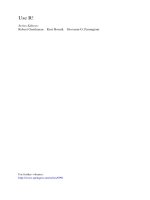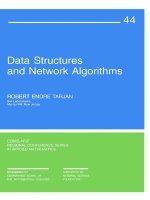IT training antifragile systems and teams khotailieu
Bạn đang xem bản rút gọn của tài liệu. Xem và tải ngay bản đầy đủ của tài liệu tại đây (5.84 MB, 20 trang )
“Velocity is the most
valuable conference I have
ever brought my team to.
For every person I took
this year, I now have three
who want to go next year.”
— Chris King, VP Operations, SpringCM
Join business technology leaders,
engineers, product managers,
system administrators, and developers
at the O’Reilly Velocity Conference.
You’ll learn from the experts—and
each other—about the strategies,
tools, and technologies that are
building and supporting successful,
real-time businesses.
Santa Clara, CA
May 27–29, 2015
/>©2015 O’Reilly Media, Inc. The O’Reilly logo is a registered trademark of O’Reilly Media, Inc. #15306
Antifragile Systems
and Teams
Dave Zwieback
Antifragile Systems and Teams
by Dave Zwieback
Copyright © 2014 O’Reilly Media, Inc. All rights reserved.
Printed in the United States of America.
Published by O’Reilly Media, Inc., 1005 Gravenstein Highway North, Sebastopol, CA
95472.
O’Reilly books may be purchased for educational, business, or sales promotional use.
Online editions are also available for most titles (). For
more information, contact our corporate/institutional sales department: 800-998-9938
or
Editor: Mike Loukides
April 2014:
First Edition
Revision History for the First Edition:
2014-04-21: First release
2015-03-24: Second release
Nutshell Handbook, the Nutshell Handbook logo, and the O’Reilly logo are registered
trademarks of O’Reilly Media, Inc. Antifragile Systems and Teams and related trade
dress are trademarks of O’Reilly Media, Inc.
Many of the designations used by manufacturers and sellers to distinguish their prod‐
ucts are claimed as trademarks. Where those designations appear in this book, and
O’Reilly Media, Inc., was aware of a trademark claim, the designations have been
printed in caps or initial caps.
While every precaution has been taken in the preparation of this book, the publisher
and authors assume no responsibility for errors or omissions, or for damages resulting
from the use of the information contained herein.
ISBN: 978-1-491-94796-8
[LSI]
Table of Contents
Antifragile Systems and Teams. . . . . . . . . . . . . . . . . . . . . . . . . . . . . . . . 1
Impermanence
Fragile, Robust, and Beyond
Antifragility
DevOps and Antifragility
Culture, Part 1: Managing the Downside
Culture, Part 2: Skin In the Game
Culture, Part 3: Tinkering (or Continual Experimentation
and Learning)
Automation and Measurement: A Cautionary Tale
Sharing
Is DevOps Antifragile?
Acknowledgments
1
2
3
4
5
7
9
10
12
12
13
iii
Antifragile Systems and Teams
Impermanence
Systems break because of change, and we often go to great lengths to
prevent or manage change with heavy-handed, bureaucratic changemanagement processes. What we forget is that systems also function
because of change.
For instance, computer systems function through state transition: 0s
changing to 1s and back again. More fundamentally, computers work
because 0s can change into 1s, because computer systems are change‐
able.
This is a somewhat subtle point, one that’s easy to overlook in search
of more tangible conditions required for systems to function or mal‐
function. But it’s worth repeating: the fundamental reason that systems
start, stop, or continue working—the one root cause of all functioning
systems and all system outages—is their changeable, impermanent
nature.
More broadly, impermanence is a fundamental property of all com‐
pounded things, i.e., those that consist of two or more parts. All of the
systems that we work with certainly have two or more parts (how about
five billion parts for the upcoming Xbox chip?).
So how can this theoretical and philosophical understanding of im‐
permanence help us? How can we make impermanence usable and
useful?
First, impermanence is useful because it reminds us that all function‐
ing systems will eventually break down. Understanding imperma‐
nence frees us from looking for the “single root cause” of outages, and
1
from the mistaken belief that there is none. (Sidney Dekker proclaims
that “What you call ‘root cause’ is simply the place where you stop
looking any further.”1) The single root cause of all outages—and all
functioning—is impermanence, the changeable nature of all systems.
Second, having accepted impermanence, we (as engineers) cannot ac‐
cept that things break or function entirely randomly. If we mixed two
parts hydrogen with one part oxygen and sometimes got water and at
other times ice cream, we might as well give up our chosen profession!
While we may not be able to identify all the conditions required to
build or keep the system running or all those that result in malfunc‐
tions, we can certainly identify some of the conditions. Engineering,
above all, is the discipline of studying conditions and their effects.
Most important, we can identify some of the conditions that we can
actually impact. While a butterfly fluttering its wings in Africa may be
one of the conditions of a hurricane resulting in a power outage in
Northern Virginia, we don’t have any control over the butterfly, but at
least we have some say in whether our data centers have backup power
generators.
Fragile, Robust, and Beyond
While all systems break eventually (because they’re all breakable, im‐
permanent), they differ in their robustness to stress. For instance,
imagine you have a very important document that you want to protect
and share widely. Let’s say you decide to store it on a physical hard disk
(the spinning platters variety) in a server connected to the Internet via
a single network connection. This particular system would be fragile,
since a failure of any single component (disk, server, network, etc.)
would make the file unavailable, possibly forever. Moreover, if the file
became widely popular, its popularity would negatively impact its
availability, as any of the subsystems could easily be saturated.
As we can see, fragile systems dislike and are harmed by even small
amounts of stress (a.k.a. volatility, randomness, disorder, or imper‐
manence). One way to reduce fragility is to increase redundancy: we
could build a more robust system by removing single points of failure
by mirroring the disks, setting up multiple servers in high-availability
1. Dekker, Sidney. The Field Guide to Understanding Human Error: Second Edition.
Farnham, Surrey, UK: Ashgate Publishing, 2006.
2
|
Antifragile Systems and Teams
configurations and distributing them geographically, adding multiple
higher-bandwidth Internet links, etc. While this system would be
more robust and increase the availability of the document, it would
remain vulnerable to somewhat rare but catastrophic conditions like
the leap second bug (because all servers ran the same version of the
OS) or equipment seizure by the government. Moreover, this is a con‐
siderably more complex system than a single-server one, and it will at
times function and break in unexpected and unpredictable ways.
We usually think of robust systems as the opposite of fragile ones be‐
cause they don’t to care too much about (i.e., neither like nor dislike)
stress. In fact, robust systems are merely less fragile. The true opposite
of a fragile system would be one that actually benefits from stress.
Nassim Nicholas Taleb calls such systems antifragile.
In the case of the aforementioned file, imagine we stored it in a system
that made it more available the higher the demand for it was. In fact,
BitTorrent is precisely this type of system: the more our file is reques‐
ted, the more robust to failure and available it becomes because parts
of it are stored on a progressively larger number of computers. In fact,
the best-case scenario for a file stored on BitTorrent is that every per‐
son on earth would want to download it and then share it. This sce‐
nario is exactly the absolute worst case for both fragile and robust
systems. Note also that our cost of distributing this file would remain
constant—not so for the cost of making systems more robust to an‐
ticipate higher demand or improve resiliency.
Antifragility
The main property of antifragile systems is that the potential downside
due to stress (and its retinue) is lower than the potential upside, up to
a point. Taleb defines this asymmetry as follows: you are antifragile to
event intensity between xlow and xhigh if you are better off after the event
than before (up to xhigh). The rare, entirely unpredictable event (a.k.a.
the Black Swan event) in which every person on earth wants to down‐
load a copy of a file distributed on BitTorrent would actually make the
file maximally available, robust to failure, and practically impossible
to delete.
BitTorrent is similar to another human/social system with antifragile
properties: information shared via gossip. The more someone (e.g., a
government or a self-righteous group) tries to suppress, criticize, or
disprove some information (e.g., an idea or a book), the more wide‐
Antifragile Systems and Teams
|
3
spread and persistent it becomes. Critics of Miley Cyrus did her a great
favor with their outraged responses to her 2013 VMA performance—
a smarter strategy would have been to ignore the train wreck entirely.
In fact, Brendan Behan’s famous observation that “there’s no bad pub‐
licity except an obituary”2 provides a nice summary of antifragility:
the downside to gossip and negative publicity (e.g., damage to one’s
reputation) is smaller than the upside (e.g., selling more records), up
to a point (e.g., death).
The longevity and popularity of some books is due in part to being
banned at one time or another; in fact, 46 of the 20th century’s top 100
novels were targets of ban attempts. From my childhood in Soviet
Russia, I remember my parents and their friends staying up nights to
read a samizdat version of The Gulag Archipelago, despite the fact that
those found in possession of the banned manuscript faced long prison
sentences. This illustrates another often overlooked property of anti‐
fragile systems: antifragility by layers. Being banned may help books
become antifragile, while reading banned books can make individuals
fragile.
More generally, complex systems contain myriad components, some‐
times organized in hierarchies or layers. As in the above example,
sometimes antifragility is achieved at a certain layer of a complex sys‐
tem at the cost of fragility of another. Another example of antifragility
by layers is vaccination: while it appears to benefit populations, vac‐
cines are known to cause serious side effects for some individuals. That
is, vaccination makes a population antifragile because the downside
(a small number of individuals having negative side effects) is small in
comparison to the upside (an entire population gaining immunity to
a disease). However, vaccination certainly makes the specific individ‐
uals who wind up having side effects or die from it fragile.
DevOps and Antifragility
DevOps is a modern organizational philosophy, which can be applied
to improve the antifragility of complex systems. (“Systems” includes
people as well as computers and software.) Let’s explore how the layers
of DevOps (Culture, Automation, Measurement, and Sharing) con‐
tribute to the overall antifragility of organizations that adopt this phi‐
losophy.
2. McCann, Sean. The World of Brendan Behan. London: Twayne Publishers, 1966. 56.
4
|
Antifragile Systems and Teams
Culture, Part 1: Managing the Downside
Etsy is known for deploying to production 40+ times per day. Netflix
routinely terminates production instances at random or introduces
latency into their application. An architect working on HP printer
firmware “would purposely make changes that would break the code
until it was architecturally correct.”3 What makes all these examples
acceptable or even possible within organizations? Fundamentally,
these organizations have realized that the potential downside of fre‐
quent changes (otherwise known as volatility, variance, etc.) is smaller
than the potential upside. This knowledge has become part of the cul‐
ture at these companies. This is also the classic asymmetry of pain
versus gain required to make these companies and their systems an‐
tifragile.
Figure 1. The Antifragile asymmetry between potential downside and
upside
The major upside of embracing higher volatility is that customers re‐
ceive higher-quality products and services (i.e., value) faster and at a
lower cost than is possible with traditional, risk- and volatility-averse
approaches. The often overlooked and critical point is that this is only
possible not only because these companies have identified potential
3. Gruver, Gary, Mike Young, and Pat Fulghum. A Practical Approach to Large-Scale Agile
Development: How HP Transformed LaserJet FutureSmart Firmware. Boston:
Addison-Wesley, 2012.
Antifragile Systems and Teams
|
5
upside, but also because they have become experts at minimizing the
downside:
At Etsy “this isn’t license to break stuff, quickly. Engineer-driven QA
and solid unit testing are integral parts of the process.”4
Netflix “is known for being bold in its rapid pursuit of innovation and
high availability, but not to the point of callousness. It is careful to
avoid any noticeable impact to customers from these failure-induction
exercises.”5
At HP “we could tell when [the architect] had found and plugged a
hole because a particular test area would have a huge drop in passing
tests or the build would break completely.”6
It is the robust testing, quality assurance, and (continuous) deploy‐
ment practices that enable these companies to reduce the possibility
of any individual change causing a catastrophic event. Both Etsy and
Netflix have become experts at quickly going back to a previously
working version of software should the newly deployed one be found
defective. Amazon takes this up a notch, performing “rollbacks” au‐
tomatically in the event that a deploy causes problems. This is one of
the reasons that only about 0.001% of software deployments at Ama‐
zon cause outages, even with the mean time between deployments a
staggering 11.6 seconds! At the same time, in all these companies, some
of the potentially risker changes (e.g., database schema or OS updates
on core routers) are certainly not performed frequently or continu‐
ously.
We should be careful not to attribute the antifragility of the above
companies entirely to effective testing or QA, or to the frequency and
the skill with which they release to production. For comparison, con‐
sider Knight Capital, which was a large global financial services firm
until trading losses forced it to be acquired in a fire sale. Knight ap‐
pears to have had reasonable testing and QA processes and an agilelike, iterative software development and deployment approach similar
to the one practiced by Etsy and Netflix:
1. Initial development phase with no market interaction.
4. />5. />6. Gruver, Gary, Mike Young, and Pat Fulghum. A Practical Approach to Large-Scale Agile
Development: How HP Transformed LaserJet FutureSmart Firmware. Boston:
Addison-Wesley, 2012.
6
|
Antifragile Systems and Teams
2. Production test phase at a limited range from the trading desk.
New strategy could be tested on one order in one symbol.
3. Wider testing, possibly of a larger order in a single stock and then
further analysis of what happened versus what was expected.
4. Once the strategy can conduct multiple orders in a variety of se‐
curities across different markets, potential beta users are
recruited.
5. When the algorithm has passed all tests, it’s deployed as a new
strategy and a performance review is done.
And yet, this turned out to be little more than “risk management the‐
atre”. On August 1, 2012, “It took only one defect in a trading algorithm
for Knight Capital to lose $440 million in about 30 minutes. That $440
million is three times the company’s annual earnings. The shock and
sell-off that followed caused Knight Capital’s stock to lose 75 percent
of its value in two business days.”7
Hidden beneath the seemingly sensible processes was the possibility
for one massive, negative Black Swan event—rare, unpredictable, and
catastrophic—to wipe out the company. In hindsight, it appears that
Knight Capital did not manage their downside effectively, and the po‐
tential downside was much larger than the upside, which made the
company fragile and eventually resulted in its demise.
Culture, Part 2: Skin In the Game
Historically, developers designed and produced software, then “threw
it over the wall” to operations people, who deployed and supported
the software in production. It was often the operations people who
would be responsible for the nonfunctional requirements such as se‐
curity, scalability, resilience, backup and recovery, and so on. When
things broke, as they invariably did (see: impermanence), it was the
operations folks who would be summoned to fix them at the proverbial
midnight hour.
This is an example of the transfer of fragility, in this case from devel‐
opers to operations. In organizations where this is possible or even
encouraged, developers essentially have no skin in the game in oper‐
ating the software that they write; in fact, having transferred all the
7. />
Antifragile Systems and Teams
|
7
downside (and fragility) to operations while keeping all the upside
(e.g., promotions, bonuses, and uninterrupted sleep), they become
(temporarily) antifragile to writing and deploying defective software!
This transfer of fragility results in the all-too-familiar “downward spi‐
ral,” the depressing antipattern that is so brilliantly documented in The
Phoenix Project by Gene Kim et al.:8 the more frequently bad code
makes it into production, the less willing the ops people are to deploy
it. With less frequent deploys, more (bad) code must be deployed each
time, increasing the complexity of deployment and the probability of
outages, and making ops even more reluctant to deploy. This ulti‐
mately results in fragility of the entire system and organization, para‐
lyzing or even causing some companies to go out of business.
It’s telling that the very opposite of this schism between developers and
operations is encoded in the word “DevOps,” which originally focused
on bringing developers and operations together. (Sadly, this is still the
colloquial understanding of the term, although DevOps does not only
apply to dev and ops.) More than just collaboration, what DevOps
relies on—and what gives DevOps organizations the possibility of be‐
coming antifragile—is skin in the game. It’s no surprise that in com‐
panies like Etsy, Netflix, and Facebook, developers themselves deploy
much of the code and are called upon to fix things when they break.
More broadly, DevOps aims to align entire organizations (not just
operations and developers) toward common goals, which ensures that
local optimization (the absence of skin in the game) doesn’t make the
overall organization fragile. This alignment is possible at more than a
superficial level only when unnecessary organizational barriers and
silos are removed, and when information is flowing openly and freely.
Not surprisingly, so-called generalists (a.k.a. multi-disciplinarians,
polymaths, Renaissance men and women, comb-shaped people, or
erudites)9 gravitate toward and thrive in DevOps organizations and
become their glue. Attracted by the fluidity of roles and the fast pace
of change, they connect disparate parts of the organization and are
unafraid to dive into new and unknown areas of knowledge. In con‐
trast, overspecialized individuals, who’ve spent years or decades hon‐
8. Kim, Gene, Kevin Behr, and George Spafford. The Phoenix Project. IT Revolution
Press, 2013.
9. />
8
|
Antifragile Systems and Teams
ing a narrow set of skills, are typically put off by what they perceive as
chaos.
Finally, it’s worth noting that generalists themselves are antifragile.
Because they can do (and learn) many things and typically are not
attached to becoming super-experts in any particular field, they are
able to take advantage of a diverse set of opportunities during their
careers. Generalists do have a small downside of not being “qualified”
for rare, highly compensated, and super-specialized jobs. But their
upside is much bigger than the downside: the more wide and diverse
their knowledge, the more opportunities they have. In contrast, spe‐
cialists may be more highly prized and compensated (especially in
large organizations) and are also subject to catastrophic events in their
careers, such as when the database they spent 20 years dissecting sud‐
denly falls out of favor.
Culture, Part 3: Tinkering (or Continual
Experimentation and Learning)
Much time is spent on planning in traditional organizations, often by
company managers, in a process that excludes non-management em‐
ployees. Planning is certainly not without benefit; however, it’s worth
noting two facts: 1) many of the most important breakthroughs and
discoveries in science and technology happened by accident (e.g.,
penicillin)10 as opposed to being results of planned research, and 2)
many of the worst human-made disasters resulted from centralized,
top-down planning (e.g., the devastating famines in Soviet Russia and
North Korea, which were both centrally planned economies).11
Of course, it’s impossible to predict groundbreaking discoveries in
advance—they are positive Black Swan events. However, it is possible
to increase the likelihood of stumbling on these breakthroughs, name‐
ly through continual experimentation and learning (otherwise known
as the Third Way of DevOps). Taleb calls this “antifragile tinkering,”
where
…mistakes are small and benign, even reversible and quickly over‐
come. They are also rich in information. So a certain system of tin‐
kering and trial and error would have the attributes of antifragility. If
10. />11. />
Antifragile Systems and Teams
|
9
you want to become antifragile, put yourself in the situation [that]
“loves mistakes” …by making these numerous and small in harm.12
For example, when Google experiments continuously, and not just for
user-visible changes, they’re doing so in an antifragile way, because the
costs of failure are small. Famously, Gmail, Google Maps, Adsense,
Google Talk, and many other products were born from Google’s (now
supposedly defunct) “20% time”, which encouraged engineers to tink‐
er and experiment on projects they found interesting. The potential
downside was limited to 20% of the company’s time, but the payoff
has been immense: a reported 50% of Google’s products originated
from this unstructured, unplanned research. Adsense alone has been
responsible for over 25% of Google’s revenue! As we’ve seen before,
this favorable asymmetry of potential losses and gains is key to anti‐
fragility.
Continual tinkering is not just random, aimless wondering. As Taleb
says, “We use randomness to spoon-feed us with discoveries—which
is why antifragility is necessary.” Failures provide meaningful, useful
signals: having failed, we know what does not work and what not to
do. So much the better to fail quickly—and inexpensively—and even‐
tually stumble onto a positive Black Swan.
Automation and Measurement: A Cautionary Tale
Both automation and measurement are key components of imple‐
menting DevOps. As tools of the trade they are concrete, easily grasp‐
able artifacts of DevOps culture, and they receive the bulk of attention
from the public. Sometimes this results in equating the DevOps phi‐
losophy with implementing the tools; of course, running Chef or Pup‐
pet (the most popular open source configuration management tools,
often labeled as “DevOps tools”) will not magically transform an or‐
ganization into a DevOps (or an antifragile) one.
Certainly the automated deployment and configuration management
tools increase both the speed and ease of deployment, and the uni‐
formity of systems. They may also enable anyone in the company to
continuously deploy into production thousands of times per day, sup‐
porting the kind of antifragile tinkering discussed above. Similarly,
12. Taleb, Nassim Nicholas. Antifragile: Things That Gain from Disorder. New York: Ran‐
dom House, Inc., 2012. Kindle locations 675—678.
10
|
Antifragile Systems and Teams
measuring and analyzing the results of experiments is absolutely re‐
quired in order to determine what’s working and what’s not.
Overreliance on measurement and automation can make systems
fragile. For instance, airline regulations now require the use of auto‐
pilot in most flying situations. Such an extensive use of automation
may have contributed to make this the safest aviation period on record.
However, the FAA has recognized that “pilots’ ‘addiction’ to automa‐
tion…has eroded their flying skills to the point that they sometimes
don’t know how to recover from stalls and other mid-flight prob‐
lems.”13 Such events are rare and unpredictable, but their potentially
catastrophic outcomes (compared to their benefits) make obvious that
excessive dependence on automation is fragile. (Ironically, when fatal
crashes do happen, air travel actually becomes safer for those not killed
in the accident—air travel, as a whole, is antifragile.)
Similarly, if the only way that software can get deployed or systems
configured is through automation tools, we are subject to a cata‐
strophic Black Swan event when automated systems are unavailable
when we attempt to deploy or configure and manual ways of accom‐
plishing these tasks are unknown or not immediately available. More‐
over, one of the biggest benefits of automation tools is that they make
systems uniform, which can also be one of the conditions for a serious
outage, as illustrated by the leap second bug mentioned previously.
Artificially constraining or enforcing uniformity is a recipe for fragile
systems.
With respect to measurement, due to a host of cognitive biases, hu‐
mans are prone to constructing stories that feel good, but are untrue.
We may find correlation or causation where there is none, or get stuck
in analysis paralysis, always looking for more and Bigger Data:
Yes, it’s true that a team at Google couldn’t decide between two blues,
so they’re testing 41 shades between each blue to see which one per‐
forms better. I had a recent debate over whether a border should be
3, 4 or 5 pixels wide, and was asked to prove my case…I’ve grown tired
of debating such minuscule design decisions. There are more exciting
design problems in this world to tackle.14
13. />14. />
Antifragile Systems and Teams
|
11
Sharing
Sharing is a critical part of the DevOps philosophy. Within a DevOps
organization, sharing is the key element of the Second Way, made
visible by an increasing “tribal knowledge,” trust, and a greater level of
collaboration between development and operations and throughout
the entire organization.
Within the wider community of DevOps practitioners, there is an
emphasis on sharing the tools and configuration (via open source) and
knowledge (e.g., DevOps architectural patterns and antipatterns via
articles and gatherings such as devopsdays). Most encouraging is the
fairly recent tendency among DevOps organizations to openly share
detailed postmortems after outages, some of which are potentially
embarrassing. (Compare this to the fact that, to this day, what actually
happened at Knight Capital is not public record and remains a matter
of speculation. This is despite the publication by the SEC of “Release
No. 70694”, which has some of the details of the incident, but is not a
full postmortem.) This sharing is antifragile: the benefits of sharing
such knowledge far outweigh the potential downside for all those in‐
volved.
Is DevOps Antifragile?
Just because an organization states that it has adopted DevOps, that
doesn’t necessarily mean that it is antifragile as a whole, or even that
it exhibits antifragile properties on some level. However, as we’ve
shown previously, there is significant overlap in practices of DevOps
organizations and those that seek the benefits of antifragility. It is also
possible that the reason why DevOps works is that, instead of at‐
tempting to constrain volatility in an unnatural and harmful way, De‐
vOps embraces and makes use of disorder, randomness, and, ulti‐
mately, impermanence.
12
|
Antifragile Systems and Teams
Acknowledgments
First and foremost, this paper is based on—and would be impossible
without—Nassim Nicholas Taleb’s superb and life-changing book,
Antifragile: Things That Gain from Disorder, published in 2012 by
Random House. I blatantly stole so many of his ideas that it would be
impossible to reference them all. Any misunderstandings and mis‐
representation of Taleb’s ideas are solely my own.
In addition, the following individuals have reviewed and materially
contributed to this paper: Damon Edwards, James Turnbull, James
Urquhart, Jan Schaumann, Jeff Sussna, Jez Humble, John Allspaw,
John Willis, Oleksiy Kovyrin, Stephen Nelson-Smith, Todd Deshane,
and Walter Blaurock.
Antifragile Systems and Teams
|
13
About the Author
Dave Zwieback has been managing large-scale, mission-critical in‐
frastructure and teams for 17 years. He is the VP of Engineering at
Next Big Sound. He was previously the Head of Infrastructure at
Knewton, managed UNIX Engineering at D.E. Shaw and Co. and en‐
terprise monitoring tools at Morgan Stanley, and also ran an infra‐
structure architecture consultancy for seven years. Follow Dave
@mindweather or at .









